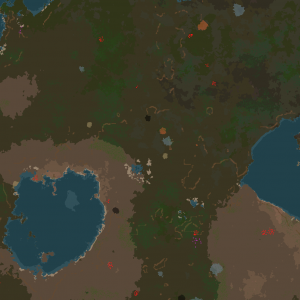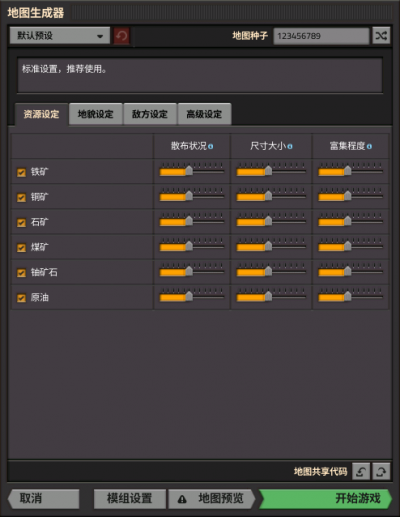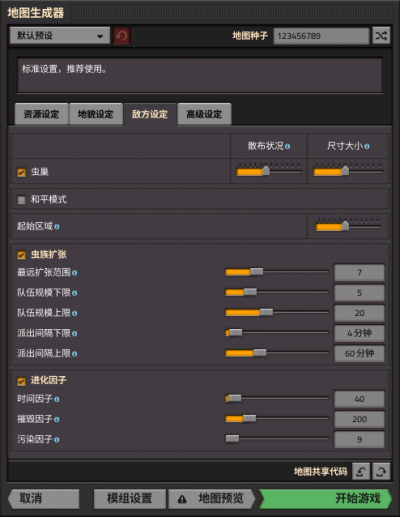游客你好,登录后能编辑wiki哦!
地图生成器
阅读
2020-04-15更新
最新编辑:逗比的马老师
阅读:
更新日期:2020-04-15
最新编辑:逗比的马老师
World generation is the procedure by which the in game landscape is generated. In short: a number of settings, editable at the start of a new world, define what that world will look like. This can dramatically alter gameplay — a new player is advised to start with the default settings before deciding to change their world.
Map generation presets
A preset may be chosen in the top left dropdown instead of manually configuring the generation.
Default
Normal settings. The recommended way to play Factorio.
All sliders are set to the center position. Map height and width is unlimited, peaceful mode is disabled.
All other settings are set to their defaults:
| Enemy expansion | Default | Evolution | Default |
|---|---|---|---|
| Enabled | Yes | Enabled | Yes |
| Maximum expansion distance | 7 | Time factor | 40 |
| Minimum group size | 5 | Destroy factor | 200 |
| Maximum group size | 20 | Pollution factor | 9 |
| Minimum cooldown (Minutes) | 4 | ||
| Maximum cooldown (Minutes) | 60 |
| Pollution | Default | Recipes/Technology | Default |
|---|---|---|---|
| Enabled | Yes | Recipe difficulty | Normal |
| Absorption modifier | 100% | Technology difficulty | Normal |
| Attack cost modifier | 100% | Technology price multiplier | 1 |
| Minimum damage to trees | 60 | Research queue availability | After the game is finished |
| Absorbed per damaged tree | 10 | ||
| Diffusion ratio | 2% |
Rich resources
Resources patches have a larger richness, so you don't have to expand far.
Difference from default: Resources have 200% richness instead of 100%.
Marathon
Recipes and technologies are more expensive.
Difference from default: Expensive recipes and technology, technology price multiplier 4.
Death world
Biters are more dangerous and evolve faster.
Difference from default: 200% enemy base frequency and 200% enemy base size, 75% starting area size, enemy evolution time factor is set to 200, pollution factor is set to 12. The pollution absorption modifier is set to 50% instead of 100%, same goes for the attack cost modifier.
Death world marathon
Recipes and technologies are expensive and biters are dangerous and plentiful. Only select this if you are a Factorio veteran.
Combines "Marathon" and "Death world" with some additional changes: Enemy evolution time factor is set to 150, pollution factor is set to 10. Attack cost modifier is set to 80% instead of 100% (50% for death world).
Rail world
Resource patches are large and spread far apart, to encourage train systems. Biters won't create any new bases or re-expand into cleared territory.
Difference from default: All resources are set to 33% frequency and 300% size. Water is set to 200% scale and 150% coverage. The evolution time factor is set to 20 from 40 and enemy expansion is disabled.
Ribbon world
The map height is limited to only 128 tiles, which introduces a range of challenges and interesting situations.
Difference from default: Map height is limited to 128. All resources are set to 300% frequency, 50% size and 200% richness. Water is set to 25% coverage and size. Starting area size is increased to 300%.
Island
A large island in an endless ocean.
Difference from default: Terrain map type is set to island.
Manual configuration
It is possible experiment with different settings by opening the map preview, changing the settings and observing their effects. This makes it possible to directly observe what exactly particular settings modify in the world, beyond the textual descriptions provided on this page.
The seed is the starting value for the random number generator that Factorio uses for generating the world based on the generation settings. This means that even with the same generation settings, the world can look very different depending on the seed.
All resources and terrain features can be disabled by unchecking the checkbox in front of them.
Resources
Frequency determines the number of resource patches in a given area. It does not affect resource patch size or richness. A setting of 200% frequency that means roughly double the patches can be found in a given area.
The size setting adjusts the size of the resource patches. Setting the slider to 200% means the surface area of the patch is doubled.
Richness defines the yield of every ore tile and every oil field. If richness is set to 200%, each ore tile and oil field contains about double the amount of ore/oil. Outside of this, resource patch richness increases by distance.
Terrain
Setting the map type to island generates a single island around the spawn point and endless ocean beyond that. The normal map type generates endless terrain.
Water scale changes how much space there is between lakes. The smaller the scale, the swampier the terrain. Higher scale leads to bigger oceans separated by bigger landmasses. Water coverage influences the overall amount of water. Reducing it generates small lakes, increasing it generates large oceans.
The settings for trees behave in the same way. Higher scale increases the distance between forests while lower scale reduces it. High tree coverage allows to completely cover the world in trees, and low coverage nearly removes them from the world.
Cliff frequency influences how many cliff lines there are in the world. Higher frequency means more cliffs, lower frequency reduces their number. The continuity setting changes how long and unbroken the cliff lines are. Low continuity leads to very short lines, high continuity to long, nearly unbroken lines of cliffs.
The moisture settings control the distribution of grass versus desert. Higher bias generates more grass, lower bias generates more desert. Higher scale increases the size of the grass/desert areas, low scale leads to small grass and desert patches.
The terrain type setting controls the distribution of red desert versus sand. Higher bias generates more red desert, lower bias generates more sand. Higher scale increases the size of the red desert/sand areas, low scale leads to small red desert and sand patches.
敌人
Frequency determines the number of enemy bases in a given area. It does not affect enemy base size. A setting of 200% frequency that means roughly double the enemy bases can be found in a given area.
The size setting adjusts the size of enemy bases. Setting the slider to 200% means the surface area covered by the enemy bases is doubled.
When peaceful mode is turned on, the 敌人 don't begin fights, only responding if the player hits them. Additionally, when a map is in peaceful mode, the enemies will not expand.
The starting area is the an almost circular radius around the spawn point that does not contain enemy bases. Increasing its size pushes the bases further out, decreasing its size generates enemy bases closer to the spawn point. The size setting does not have any other effects.
Enemy expansion can be enabled/disabled and further adjusted using the below settings.
| Enemy expansion setting | Description |
|---|---|
| Maximum expansion distance | The maximum distance enemies will look to expand from other enemy bases. |
| Minimum group size | The minimum size of an enemy expansion party modified by the current evolution level. |
| Maximum group size | The maximum size of an enemy expansion party modified by the current evolution level. |
| Minimum cooldown (Minutes) | The minimum time between enemy expansions being sent out. |
| Maximum cooldown (Minutes) | The maximum time between enemy expansions being sent out. |
Evolution can be enabled/disabled and further adjusted using the below settings.
| Evolution setting | Description |
|---|---|
| Time factor | Controls how fast evolution increases over time. |
| Destroy factor | Controls how fast evolution increases due to destroying enemy spawners. |
| Pollution factor | Controls how fast evolution increases due to producing pollution. |
Advanced
The 回放 can record all the actions that the player(s) perform during the game, so that they can later be played back as essentially a timelapse of the save file.
The map width and height allows to generate maps with finite resources and area. It is possible to limit generation in only direction, alike the ribbon world.
The difficulty settings allow to change the recipe/technology difficulty and multiply the technology cost. Currently, setting the technology difficulty does not have an effect in vanilla. Furthermore, it can be controlled when the research queue is available: From the start, after launching a rocket or never.
污染 can be enabled/disabled and further adjusted using the below settings.
| Pollution setting | Description |
|---|---|
| Absorption modifier | Modifier of how much pollution is absorbed by trees and tiles. |
| Attack cost modifier | Modifier of how much pollution is absorbed by enemy attacks. |
| Minimum damage to trees | Trees have 4 different stages of the progression towards being destroyed by pollution. Any pollution above this amount starts the process of moving a tree towards a more damaged stage. |
| Absorbed per damaged tree | Trees have 4 different stages of the progression towards being destroyed by pollution. This value specifies how much pollution is absorbed when moving to a more damaged stage. |
| Diffusion ratio | The amount of pollution diffused into neighboring chunks per second. |
地图共享代码
地图共享代码通常如下所示:
>>>eNpjYBBi4GEAgwZ7EOZgSc5PzIHxQJgrOb+gILVIN78oFVmYM 7moNCVVNz8TVXFqXmpupW5SYjGKYo7Movw8dBNYi0vy81BFSopSU 4uRRbhLixLzMktz0fUyMIqejWZvaJFjAOH/9QwK//+DMJD1AOgXE GZgbICoBIrBAGtyTmZaGgODgiMQO4GkGRkZq0XWuT+smmLPCFGj5 wBlfICKHEiCiXjCGH4OOKVUYAwTJHOMweAzEgNiaQnQCqgqDgcEA yLZApJkZOx9u3XB92MX7Bj/rPx4yTcpwZ7R0FXk3QejdXZASXaQP 5ngxKyZILAT5hUGmJkP7KFSN+0Zz54BgTf2jKwgHSIgwsECSBzwZ mZgFOADshb0AAkFGQaY0+xgxog4MKaBwTeYTx7DGJft0f0BDAgbk OFyIOIEiABbCHcZI4Tp0O/A6CAPk5VEKAHqN2JAdkMKwocnYdYeR rIfzSGYEYHsDzQRFQcs0cAFsjAFTrxghrsGGJ4X2GE8h/kOjMwgB kjVF6AYhAeSgRkFoQUcmBkQAJgs9u7hKwMAlHOggw==<<<
The map exchange string can be used to share all map generation settings between different players. The player can paste the string (using CTRL + V) into the map exchange string field and the game will set the generation settings to the settings saved in the string, resulting in a complete copy of the map when generated.
The map exchange string can be retrieved from save files by going into the load game screen, selecting the desired map, clicking the map exchange string button in the upper right corner and copying the string from the window that pops up.
For a technical description of the map exchange string, see map exchange string format.
Mechanics
Starting area
There is a second internal starting area that is completely separate from the starting area that can be changed in the enemy settings tab. This starting area always has a constant size and affects the spawning of resources, cliffs and water directly at the spawn. The map generation logic makes sure that there is always at least one patch of 煤, 铁矿, 铜矿, and 石矿 each. Furthermore, there is always a lake in the starting area, even when water is turned off, and there are never any cliffs there. 铀矿 and 原油 do not spawn in the starting area. The richness of the ore patches is slightly influenced by the frequency setting.[1]
Chunks
A map is endless by default, though its size can be limited by height and width — see above. Because it is technically endless, the whole map is not generated from the start. Instead, a new chunk of the map is generated only when needed, similar to other procedurally generated world games.
Invisible chunks (fog of war)
Outside of the visible chunk area, an invisible area of about 3 chunks wide is generated as a preloading mechanism. Enemies may be located inside these invisible chunks and can attack the player from there, while artillery turrets and wagons may automatically shoot enemy bases in these chunks if they are within their automatic range. Invisible chunks are also generated if pollution is generated heavily; the game generates (invisible) chunks as it needs to spread the pollution into the area.
Charting (removing fog of war)
As long as a chunk is invisible, the part of the players map stays black. This changes when a chunk is charted, which means when it is "touched" by a radar. This can be either the player's internal radar, which is always available and continually charts chunks around the player, or the radar entity. If a far-away and thus ungenerated chunk is charted, it will be generated, together with the above-mentioned invisible 3 chunk radius of map around it.
Maximum map size and used memory
The map size is limited to 2,000 x 2,000 kilometers; internally, this is a square 2,000,000 tiles on a side, with an area of 4,000,000,000,000 (4 trillion) square tiles (assuming 1 tile = 1 meter on a side yields 2,000 x 2,000 km = 4 million square km). In real-world terms, this is between the sizes of India and Australia (or about 40% the area of the United States, or over 10 times the area of Germany). It would take around 200 game-minutes (ca 3.3 hours real time) to reach that border from the center when riding a train fueled with rocket or nuclear fuel. This makes the world essentially endless for practical purposes. The generated chunks are fully mapped and stored in the player's RAM, which is the practical limiting factor of exploration.
Because chunks are only generated in and close around the area revealed by radar, it is possible to reach that border without overloading your computer, as the size of the map in computer memory is dependent only on chunks actually generated. If only a narrow stripe of land is explored to far away, this remains manageable.
历史
- 0.17.44:
- The resource frequency slider in the map generator settings has a smaller influence over the amount of ore in the starting area patches.
- 0.17.0:
- Resource generation changed significantly:
- The starting area contains only iron, copper, coal and stone, in very predictable amounts. Uranium and oil are excluded from the starting area.
- Resource generation settings now have a much more dramatic effect. Increased the number of steps for each setting.
- Ore patches are slightly less frequent but richer.
- There will be a more balanced amount of resources within a large enough region.
- Many other small tweaks.
- Biter generation changed significantly:
- Biter richness slider removed, biter placement is only configured by size and frequency settings.
- Biter generation settings now have a much more dramatic effect. Increased the number of steps for each setting.
- Biter bases will increase in size, frequency and number of worms depending on the distance from player spawn.
- Worm size increases depending on the distance from player spawn.
- Small biter bases are now closer to the player spawn.
- At large distances from player spawn, biter base frequency is lower than before but biter bases are larger.
- Other small tweaks.
- Terrain generation changed significantly:
- Water is generated as large lakes instead of swamps.
- Tile generation improved. Tile placement respects biomes better.
- More predictable cliff placement.
- Better controls in the map generator GUI for water, tiles and cliffs.
- New map terrain type selectable: Island. Launch the rocket with only a limited amount of resources available on the map.
- Resource generation changed significantly:
- 0.16.0:
- Added cliffs.
- New terrains and new terrain generation.
- Trees can now be configured in the generate-map GUI.
- Terrain can be configured in the generate map GUI.
- Biters scale less with distance and there are generally less biters.
- No uranium as a starting resource also no uranium is ever generated near the starting area, you need to go look for it.
- 0.15.0:
- Extended map generator settings to include an advanced section.
- Added map generator presets.
- The map seed is used to generate unique maps instead of just shifting the starting position.
- 0.13.7:
- Map size is now limited to 2000 km by 2000 km with a black bar rather than crashing when reaching this distance.
- 0.13.0:
- Map generator algorithm changed, further resource field now have greater richness.
See also
- Some technical info
- Temperature based biome-model (how trees are placed)





 沪公网安备 31011002002714 号
沪公网安备 31011002002714 号